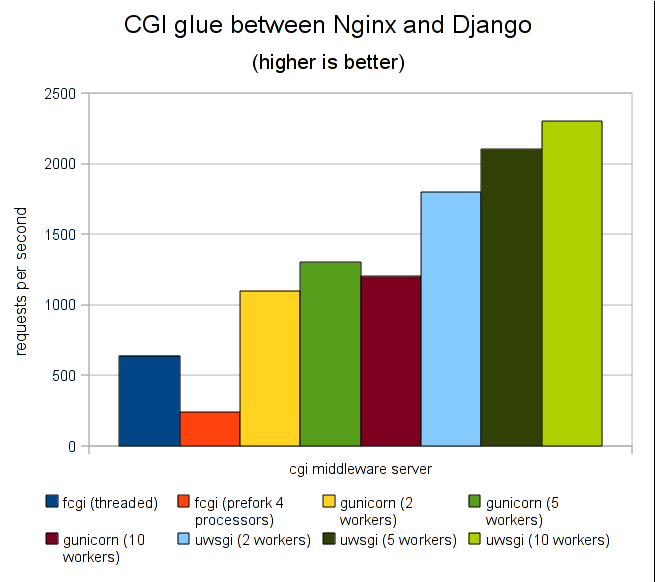您好,登錄后才能下訂單哦!
您好,登錄后才能下訂單哦!
如何在生產上部署Django?
Django的部署可以有很多方式,采用nginx+uwsgi的方式是其中比較常見的一種方式。
uwsgi介紹
uWSGI是一個Web服務器,它實現了WSGI協議、uwsgi、http等協議。Nginx中HttpUwsgiModule的作用是與uWSGI服務器進行交換。
要注意 WSGI / uwsgi / uWSGI 這三個概念的區分。
1.WSGI是一種Web服務器網關接口。它是一個Web服務器(如nginx,uWSGI等服務器)與web應用(如用Flask框架寫的程序)通信的一種規范。
2.uwsgi是一種線路協議而不是通信協議,在此常用于在uWSGI服務器與其他網絡服務器的數據通信。
3.而uWSGI是實現了uwsgi和WSGI兩種協議的Web服務器。
4.uwsgi協議是一個uWSGI服務器自有的協議,它用于定義傳輸信息的類型(type of information),每一個uwsgi packet前4byte為傳輸信息類型描述,它與WSGI相比是兩樣東西。
uwsgi性能非常高

uWSGI的主要特點如下
1.超快的性能
2.低內存占用(實測為apache2的mod_wsgi的一半左右)
3.多app管理(終于不用冥思苦想下個app用哪個端口比較好了-.-)
4.詳盡的日志功能(可以用來分析app性能和瓶頸)
5.高度可定制(內存大小限制,服務一定次數后重啟等)
總而言之uwgi是個部署用的好東東,正如uWSGI作者所吹噓的:
If you are searching for a simple wsgi-only server, uWSGI is not for you, but if you are building a real (production-ready) app that need to be rock-solid, fast and easy to distribute/optimize for various load-average, you will pathetically and morbidly fall in love (we hope) with uWSGI.
Uwsgi 安裝使用
# Install the latest stable release: pip install uwsgi # ... or if you want to install the latest LTS (long term support) release, pip install https://projects.unbit.it/downloads/uwsgi-lts.tar.gz
基本測試
Create a file called test.py:
# test.py
def application(env, start_response):
start_response('200 OK', [('Content-Type','text/html')])
return [b"Hello World"] # python3
#return ["Hello World"] # python2
運行
uwsgi --http :8000 --wsgi-file test.py
用uwsgi 啟動django
uwsgi --http :8000 --module mysite.wsgi
可以把參數寫到配置文件里
alex@alex-ubuntu:~/uwsgi-test$ more crazye-uwsgi.ini [uwsgi] http = :9000 #the local unix socket file than commnuincate to Nginx socket = 127.0.0.1:8001 # the base directory (full path) chdir = /home/alex/CrazyEye # Django's wsgi file wsgi-file = CrazyEye/wsgi.py # maximum number of worker processes processes = 4 #thread numbers startched in each worker process threads = 2 #monitor uwsgi status stats = 127.0.0.1:9191 # clear environment on exit vacuum = true
啟動
/usr/local/bin/uwsgi crazye-uwsgi.ini
Nginx安裝使用
sudo apt-get install nginx sudo /etc/init.d/nginx start # start nginx
為你的項目生成Nginx配置文件
You will need the uwsgi_params file, which is available in the nginx directory of the uWSGI distribution, or from https://github.com/nginx/nginx/blob/master/conf/uwsgi_params
Copy it into your project directory. In a moment we will tell nginx to refer to it.
Now create a file called mysite_nginx.conf, and put this in it:
# mysite_nginx.conf
# the upstream component nginx needs to connect to
upstream django {
# server unix:///path/to/your/mysite/mysite.sock; # for a file socket
server 127.0.0.1:8001; # for a web port socket (we'll use this first)
}
# configuration of the server
server {
# the port your site will be served on
listen 8000;
# the domain name it will serve for
server_name .example.com; # substitute your machine's IP address or FQDN
charset utf-8;
# max upload size
client_max_body_size 75M; # adjust to taste
# Django media
location /media {
alias /path/to/your/mysite/media; # your Django project's media files - amend as required
}
location /static {
alias /path/to/your/mysite/static; # your Django project's static files - amend as required
}
# Finally, send all non-media requests to the Django server.
location / {
uwsgi_pass django;
include /path/to/your/mysite/uwsgi_params; # the uwsgi_params file you installed
}
}
This conf file tells nginx to serve up media and static files from the filesystem, as well as handle requests that require Django's intervention. For a large deployment it is considered good practice to let one server handle static/media files, and another handle Django applications, but for now, this will do just fine.
Symlink to this file from /etc/nginx/sites-enabled so nginx can see it:
sudo ln -s ~/path/to/your/mysite/mysite_nginx.conf /etc/nginx/sites-enabled/
Deploying static files
Before running nginx, you have to collect all Django static files in the static folder. First of all you have to edit mysite/settings.py adding:
STATIC_ROOT = os.path.join(BASE_DIR, "static/")
and then run
python manage.py collectstatic
此時啟動Nginx 和Uwsgi,你的django項目就可以實現高并發啦!
以上就是本文的全部內容,希望對大家的學習有所幫助,也希望大家多多支持億速云。
免責聲明:本站發布的內容(圖片、視頻和文字)以原創、轉載和分享為主,文章觀點不代表本網站立場,如果涉及侵權請聯系站長郵箱:is@yisu.com進行舉報,并提供相關證據,一經查實,將立刻刪除涉嫌侵權內容。